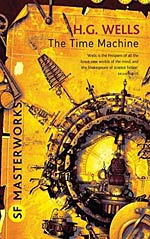
![]() Sable Aradia
Sable Aradia
10/6/2017
![]()
Read for the Need to Reread Challenge.
I have, of course, read most of H.G. Wells before. He was one of my early introductions to science fiction. After we did the radio play The Invisible Man in school (I was eight or nine) I asked my school librarian about that novel. We didn't have The Invisible Man, but we did have The Time Machine, and he was only too happy to point me that way. And I, of course, devoured it.
From a retrospective, the Time Machine suffers from many of the problems that 19th century novels often do. The art form was new then, so no one really had an idea of how to do it, and thus, things that we would consider signs of poor writing now were a part of the landscape then. In particular, Wells uses long words and paragraphs when short ones would do, and he does not fully develop his one female character as anything more than a childlike figure that he must take care of. However, the book is action-packed and powerful, and it keeps you turning pages.
And obviously its images stay with you a long time. I remembered the Eloi and the Morlocks vividly (though I still have no idea where the Time Traveler learned their names). Strangely, I did not remember his brief sojourn to the end of the Earth at all. Perhaps that was just too big for me to grasp at such a young age. As an adult, it was both moving and terrifying. I see now that this book is, in part, an extended meditation on the futility of civilization and our efforts to immortalize ourselves. There was an extended scene in a museum that had gone to seed in the world of the Eloi that also drove home this message. Powerful stuff, and of course, a must read for every fan of science fiction, if not everyone in our culture, period.
http://dianemorrison.wordpress.com